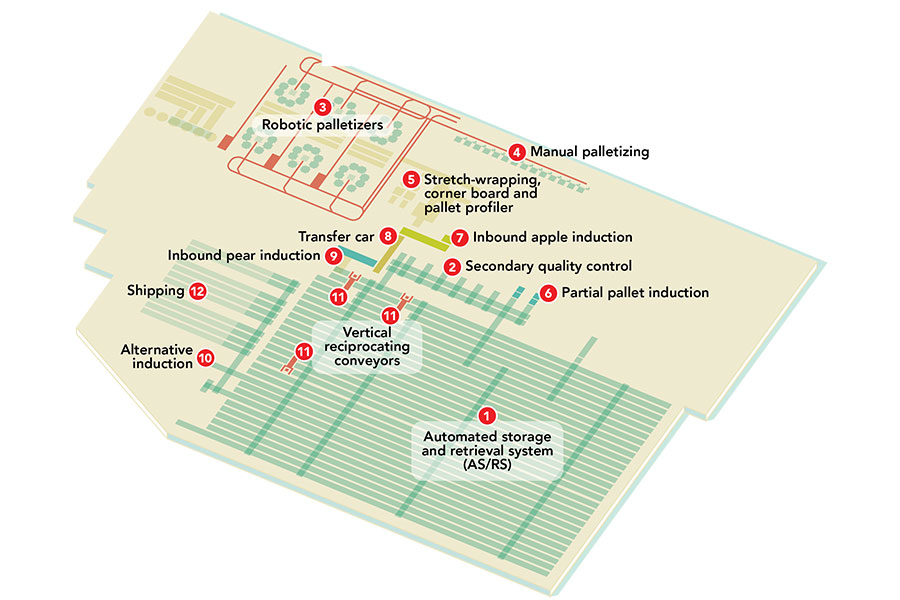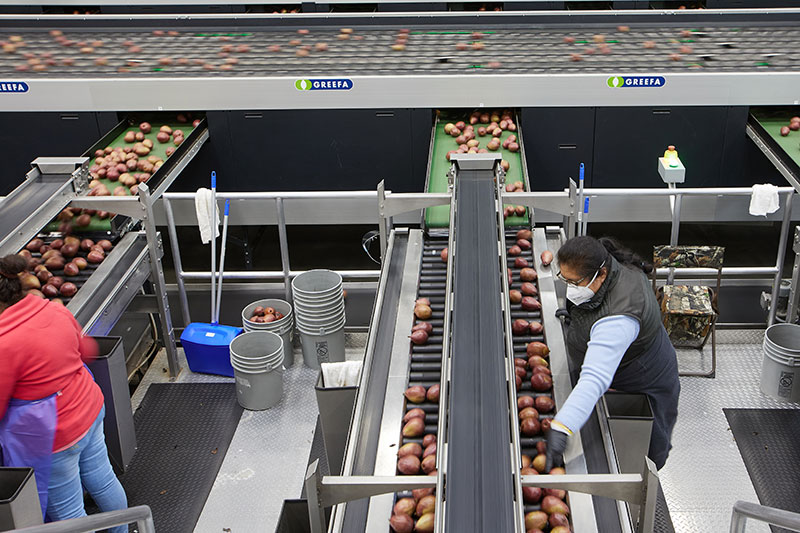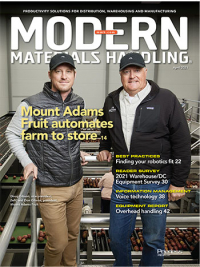Inside Mount Adams Fruit: Bringing automation to fresh fruit distribution
In Washington State, Mount Adams Fruit is using a mix of automation to take a leadership position in the apple and pear industry.
Mount Adams Fruit
Bingen, Washington
- Square Footage: 250,000 square feet
- Automated Storage and Retrieval: 7 levels of storage, including the floor level, reaching 80 feet tall. 5,916 pallet positions are serviced by 17 pallet rovers, 3 vertical reciprocating lifts and 20 opportunity chargers.
- Products Handled: Pears and apples
- SKUs: 1,000
- Throughput: The system is currently putting 60 pallets per hour into storage and retrieving 22 pallet an hour, with capacity to retrieve 45 pallets per hour
- Shifts Per Day/ Days Per Week:1 shift per day in shipping and production; inventory analysis and re-slotting occurs overnight
Mount Adams Fruit’s new, highly automated distribution center is essentially a finished-goods warehouse. In this instance, the automated warehouse receives and stores fresh fruit. Handling begins in the processing area (not shown). Prior to fruit arriving at Mount Adams Fruit from the fields, an estimate of what will arrive is entered into Salesforce.com, which is used for production planning. Fruit arrives from the fields in bins that are stored in temperature-controlled rooms that control ripening until fruit is ready to be packed.
Once the fruit is ready to be packed, it is cleaned in water, dried and conveyed to a defect sorter, which includes a vision system that can evaluate the fruit internally and externally. Mount Adams Fruit uses artificial intelligence (AI) to determine what kind of box the fruit will go into based on grading and size.
Once the fruit is cleared for packing, it is packed by hand into shipping boxes. Packed boxes are conveyed to an automatic stamping line that creates a unique identifier for that box. The license plate code identifies the farmer, the lot, the pack date, the grade, size, packing style and pallet. That information is entered into Salesforce.com and the product is ready for storage and available for sales.
Receiving
Once boxes have been packed, they are conveyed to the floor level where they are prepped for putaway into the automated storage and retrieval system (1). Adjacent to the AS/RS is a second quality control area (2), where stored fruit that requires another review, and potentially a repack, is inspected.
A majority of boxes will be palletized by a module with six robotic palletizers (3). A second palletizing area (4) is used to manually build pallets. Once a pallet has been built, it is conveyed to an automatic stretch-wrapping area (5). There, a protective corner board is automatically applied before the pallet is stretch-wrapped and tagged with an identification label.
After a pallet is wrapped and ready for storage, it is conveyed to a profile station that determines the height of the pallet– the AS/RS features four levels that store pallets that are 96 inches high or less and three levels that store pallets that are 72 inches or less. Pallets are now ready for induction into the AS/RS.
There are four induction stations. Lift trucks deliver pallets to an area designated for partial and miscellaneous pallets (6). A second induction area receives inbound apples (7). Those pallets are delivered to the AS/RS by a transfer car (8). A third area receives inbound pears (9). Lift trucks deliver pallets to the fourth area (10), which has 22 pallet positions.
Storage
Once a pallet is conveyed into the AS/RS, it is picked up by an automatic pallet shuttle, or rover. The shuttles can move in all directions on a given level. Pallets that are stored on the floor level are delivered to a storage location that is tracked in the warehouse management system. Pallets that will be stored on one of the six upper levels are delivered to one of three vertical reciprocating conveyors (11). When the conveyor reaches the right level for that pallet, it’s picked up by a pallet shuttle and putaway into a storage location.
Further handling: After storage, fruit may be retrieved for repacking: For example, some fruit may be repacked into bags for easy handling in a store. Or, it may be re-inspected and re-packed to ensure quality. Finally, once there is an order for a pallet, it is retrieved and delivered to the shipping area (12), where it is staged on pallet conveyor for loading.

System suppliers
- System Design & Integration, AS/AR Storage Rack, Transfer Car & Pallet Conveyor Used by the AS/RS: Advance Storage Products
- Pallet-Handling Shuttle System, Fleet Management System: Advance Storage Automation
- Warehouse Management & Control System: InVar
- Order Management System: Salesforce
- Vertical Reciprocating Conveyor/AS/RS: Stocklin Logistik AG
- Pallet Conveyor: Alba Manufacturing
- Case Handling Conveyor: Hytrol
- Robotic Palletizing System: Design and integration: JPM Solutions
- Case handling robots: Kawasaki Robotics
- Lift Trucks: Hyster
- Stretch Wrap: Phoenix

Article Topics
Automation News & Resources
Beckhoff USA opens new office in Austin, Texas ASME Foundation wins grant for technical workforce development Walmart chooses Swisslog AS/RS and software for third milk processing facility Lucas Watson appointed CSO for Körber’s Parcel Logistics business in North America Kathleen Phelps to join FORTNA as chief financial officer Coles automates grocery distribution in Australia 2024 Intralogistics Robotics Survey: Robot demand surges More AutomationLatest in Materials Handling
Geek+ and System Teknik deploy PopPick solution for pharmacy group Med24.dk Beckhoff USA opens new office in Austin, Texas Manhattan Associates selects TeamViewer as partner for warehouse vision picking ASME Foundation wins grant for technical workforce development The (Not So) Secret Weapons: How Key Cabinets and Asset Management Lockers Are Changing Supply Chain Operations MODEX C-Suite Interview with Harold Vanasse: The perfect blend of automation and sustainability Consultant and industry leader John M. Hill passes on at age 86 More Materials HandlingAbout the Author
Subscribe to Materials Handling Magazine

Find out what the world's most innovative companies are doing to improve productivity in their plants and distribution centers.
Start your FREE subscription today.
April 2024 Modern Materials Handling

Latest Resources












